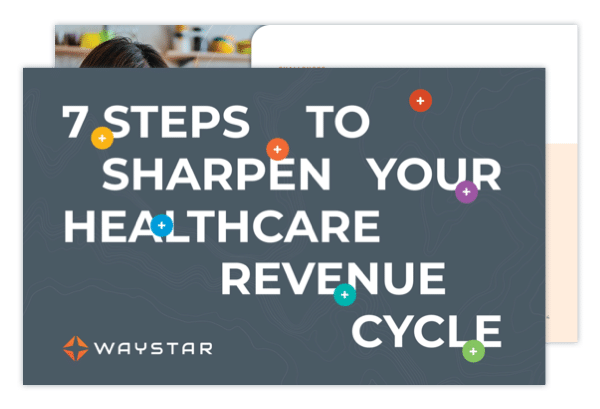This is the third post in a new Waystar blog series: 7 steps to sharpen your healthcare revenue cycle.
Can’t wait for a new blog each week? Download the eBook to learn 7 steps for maximizing your healthcare RCM software.
Before looking at the patient financial experience, it’s key to understand one fact: patient financial responsibility has increased significantly in the past few years, and it’s only projected to grow more.
With a staggering amount of patient bad debt on the horizon, it’s crucial to execute a reliable pre-visit clearance process. The good news: executing this process is also vital to creating a positive patient financial experience.
Patient financial experience tip:
1. Estimate + explain
Some aspects of financial clearance are well-known, such as verifying:
- Insurance coverage
- Benefits eligibility
- Financial responsibility, including unmet deductibles
But today, a successful financial-clearance process hinges on something new: transparently communicating this information to the patient. Keeping a patient in the dark for weeks or months about their charges not only leads to dissatisfaction; it also leads to nonpayment. Yet murky information, unexpected charges, and failure to communicate in a timely manner are all too common today.
To empower a patient, you must focus on price explanation in addition to price transparency. Talk about financial responsibility — before the service is rendered, at the time of service, or as soon as possible afterward.
a. Pre-visit process
For a pre-visit process to be successful, submitting charges to patients can’t be your last step. In order to transform the clearance process, you must estimate and communicate the patient’s financial responsibility, including any unmet deductibles, before service. Ideally, that communication will include multiple payment options, such as text to pay, payment plans, and financial assistance. When patients have information and options, they can focus on a process that yields positive results instead of on the expense.
b. Financial aid
If a patient can’t take on their financial responsibility, try to offer other pathways. Transition the patient into a financial assistance program, or offer discounts to those experiencing financial hardship. Keeping the lines of communication open is especially important for patients who are struggling.
c. Transparency
The value of patient-physician communication is long established in clinical matters, but it can also play an important role financially. Telling the patient about problems, such as difficulty confirming their insurance coverage, reduces denials and improves cash flow. Furthermore, those efforts will facilitate compliance with state and federal regulations for price transparency.
PAtient financial experience TIP:
2. Rebrand collections
To create a successful pre-visit financial clearance process, savvy healthcare organizations are restructuring collections. Many are migrating their efforts from expensive, largely ineffective units based in the business office to pre-service collections teams.

While these teams may require the same amount of staff resources as the business office, they exact a much higher amount of collections. If you can make this move, consider a change in title — your collectors become “financial advocates,” a more patient-friendly term.
PAtient financial experience TIP:
3. Combine forces
If moving your patient-collections efforts to a pre-service basis is beyond your reach today, consider combining your business office and scheduling teams.
Traditionally:
- The business office places outbound calls all day to patients who owe money (often with little success in reaching them), while
- The scheduling team accepts calls from patients all day long.
Eliminate this strict division of duties. Train your schedulers to identify balances and ask for payment via credit card. If you can invest in this process, it will quickly create a positive return.
Supplement your efforts by collecting from patients when they self-schedule, and when they check in for their appointment. Even if money doesn’t exchange hands, you’ve started to set patients’ expectations that you are serious about collecting the money they owe.
Want to know more about optimizing your rev cycle?
- Read all the blogs in this series
- Watch the webinar with Dr. Elizabeth Woodcock
- Download the complete eBook



